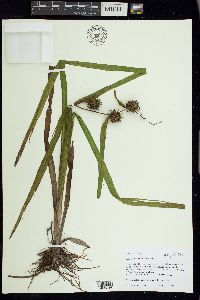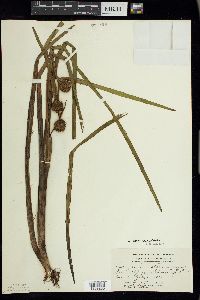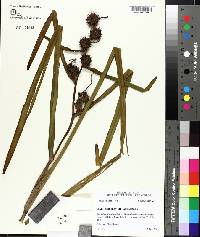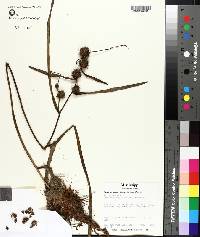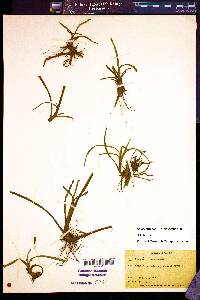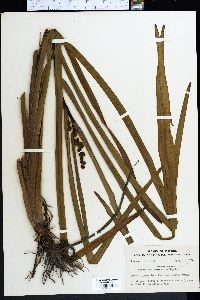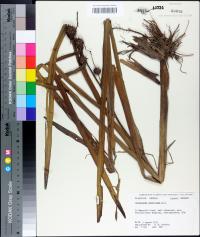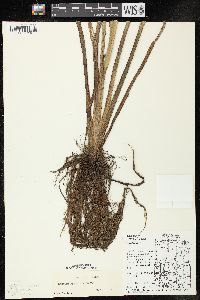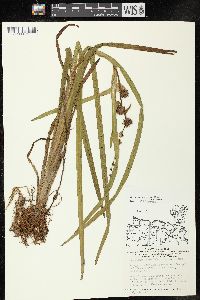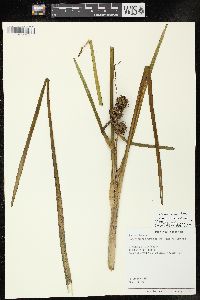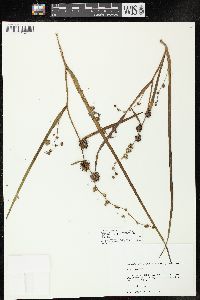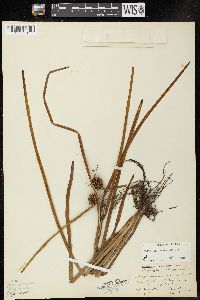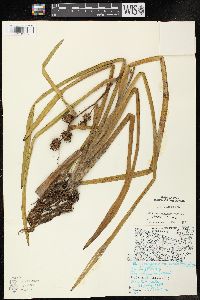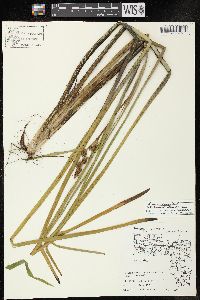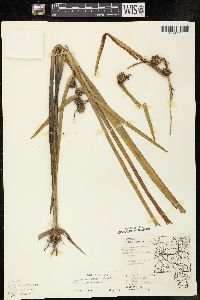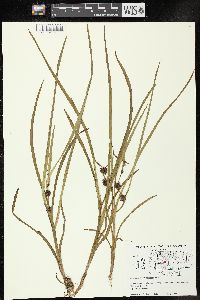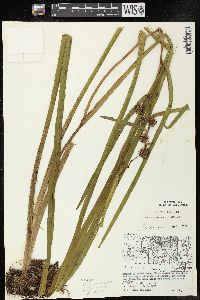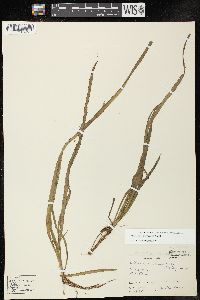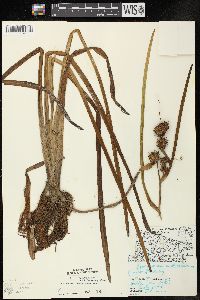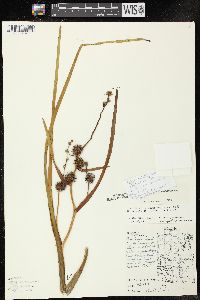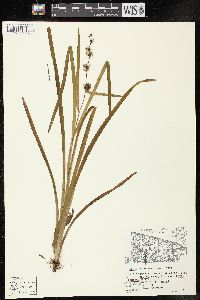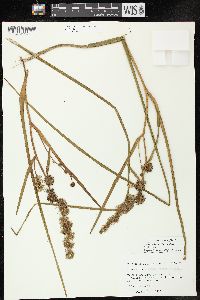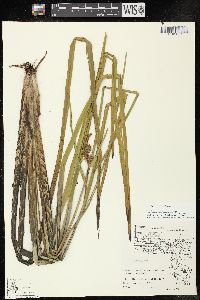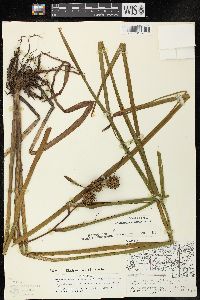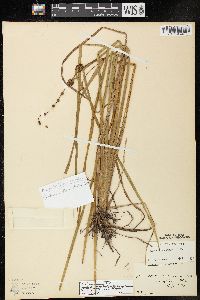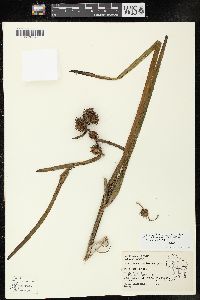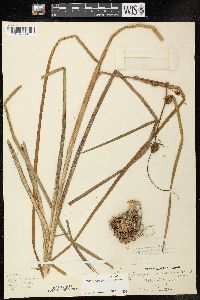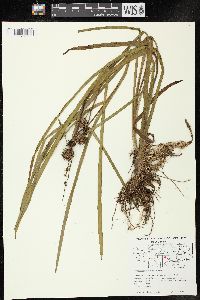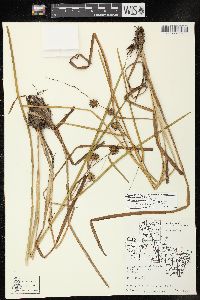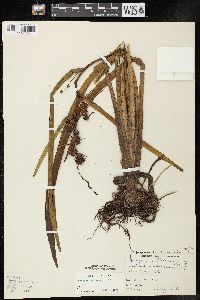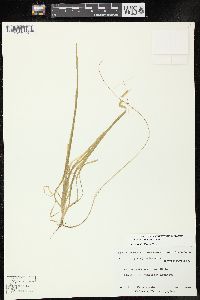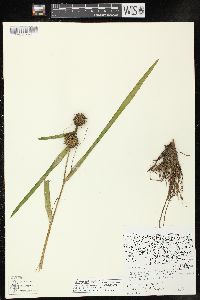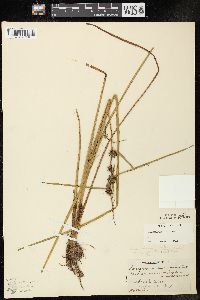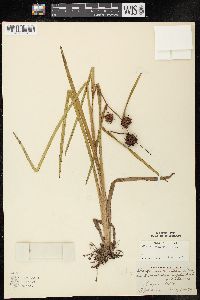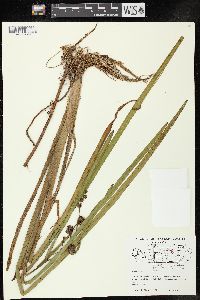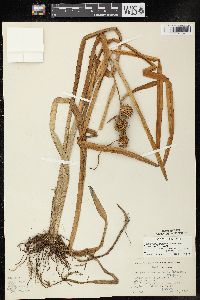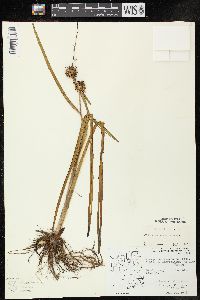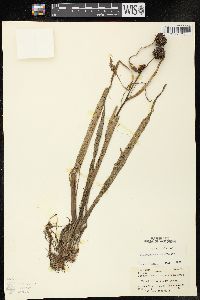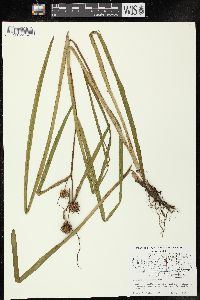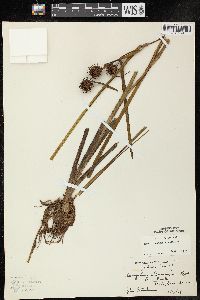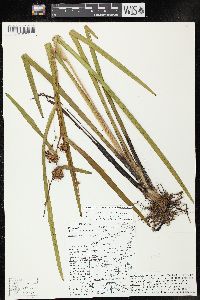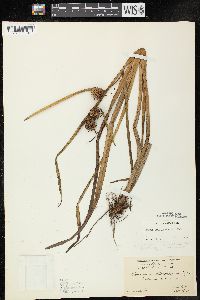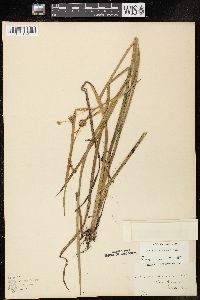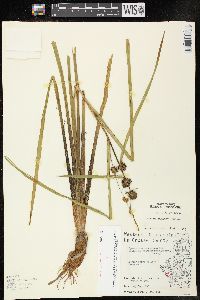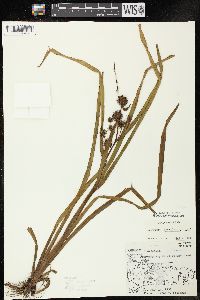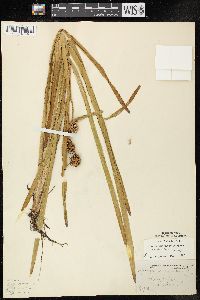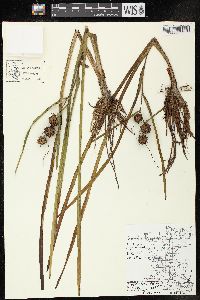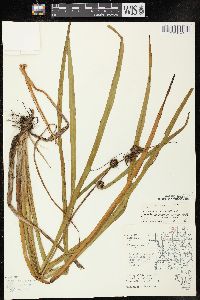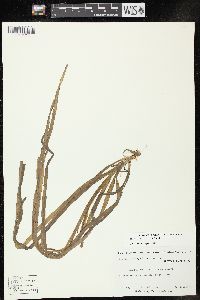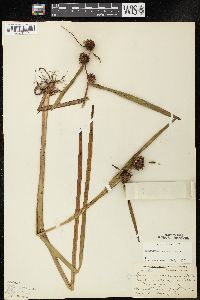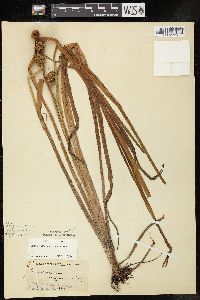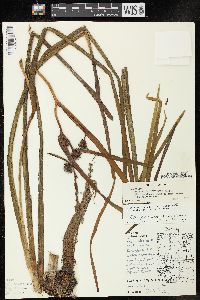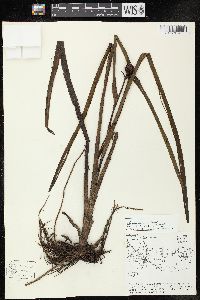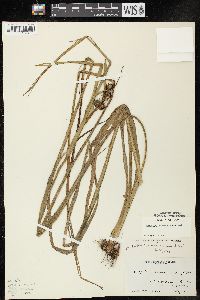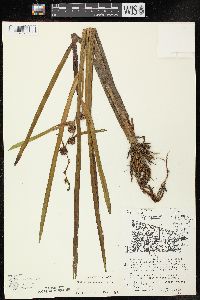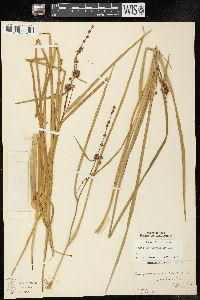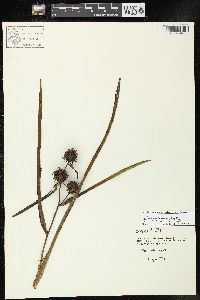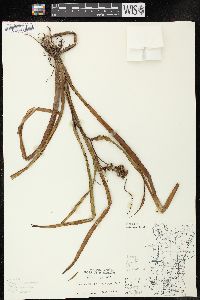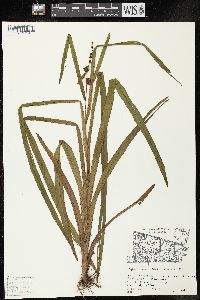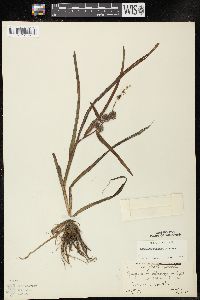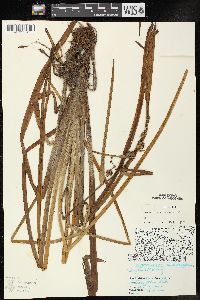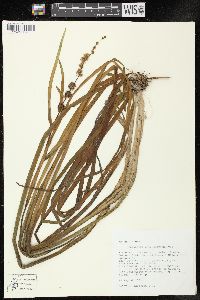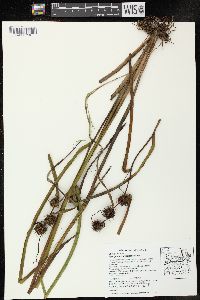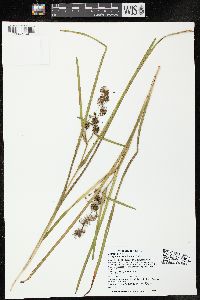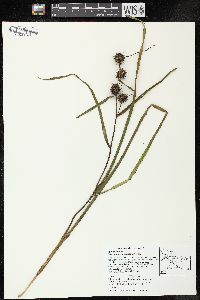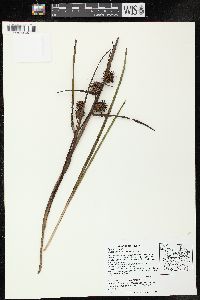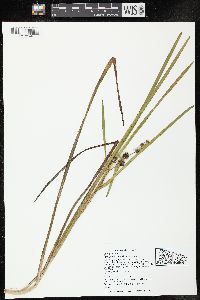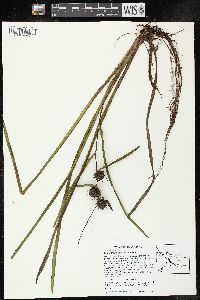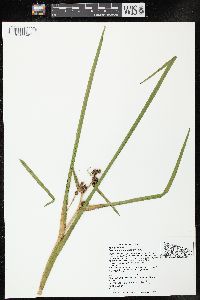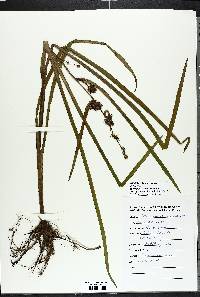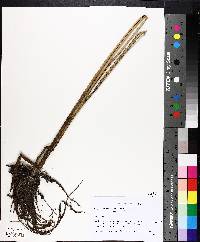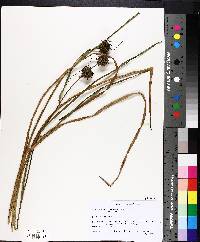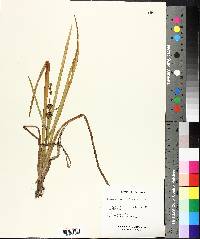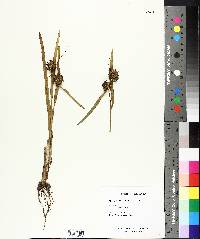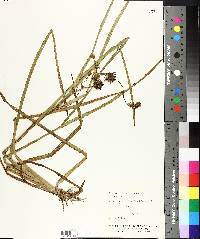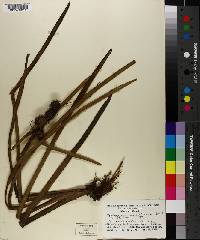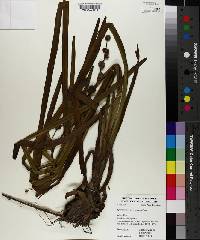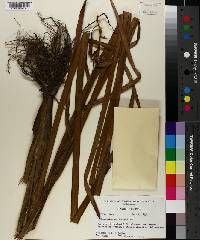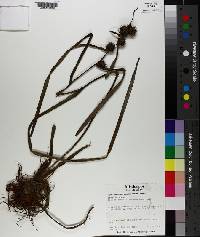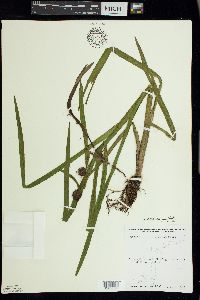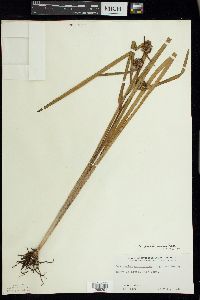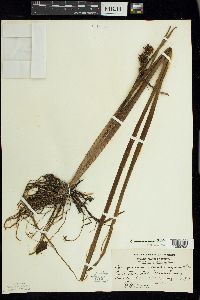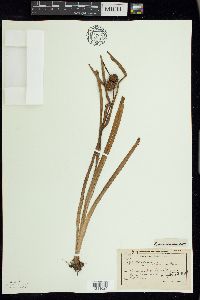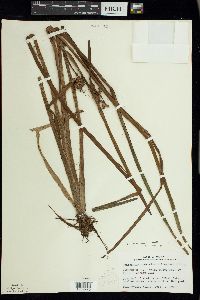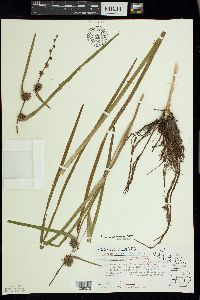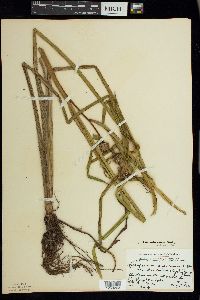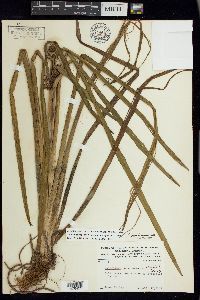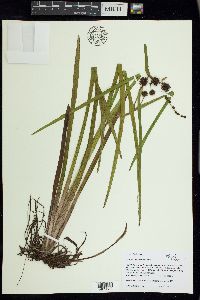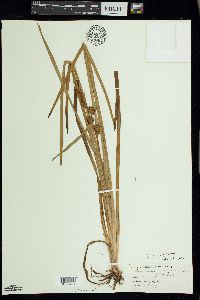Sparganium americanum
|
|
|
|
Family: Typhaceae
American Burr-Reed, more...American bur-reed
[Sparganium americanum var. rigidum R.T.Clausen, moreSparganium simplex var. nuttallii Engelm.] |
Plants slender and grasslike to usually robust, to 1 m; leaves and inflorescences usually emergent. Leaves erect but not especially stiff, usually keeled only near base, flattened distally, to 1 m 6--12 mm. Inflorescences: rachis 0--3-branched, erect; bracts somewhat ascending, not basally inflated; pistillate heads 1--3 on branches, 2--6 on main rachis, axillary, not contiguous at anthesis, sessile, 1.5--2.5 cm diam. and often contiguous in fruit; staminate heads usually 3--7 on each branch, 4--10 on main rachis, not or barely contiguous. Flowers: tepals often with prominent subapical dark spot, entire to crenulate or emarginate; stigma 1, linear-lanceolate. Fruits tan to dark greenish brown, dull, subsessile to stipitate, fusiform, sometimes barely constricted near equator, body not strongly faceted, 3.5--5(--7) mm, tapering to beak; beak usually curved, not hooked, 3--5 mm; tepals attached at base, reaching equator or slightly beyond. Seeds 1. Flowering late spring--summer (Apr--Jun southwestward, May--Sep southeastward, Jun--Aug northward). Shores and shallow neutral-to-alkaline waters, sometimes forming large stands; 0--800 m; St. Pierre and Miquelon; Man., N.B., Nfld. and Labr. (Nfld.), N.S., Ont., P.E.I., Que.; Ala., Ark., Conn., Del., Fla., Ga., Ill., Ind., Iowa, Kans., Ky., La., Maine, Md., Mass., Mich., Minn., Miss., Mo., N.H., N.J., N.Y., N.C., Ohio, Okla., Pa., R.I., S.C., Tenn., Tex., Vt., Va., W.Va., Wis.; Mexico (Durango). For differences between this highly polymorphic species and the similar but less variable Sparganium androcladum, see the discussion under that species. Also see the discussion under S. emersum. E. O. Beal (1977) recognized three morphologically overlapping races of Sparganium americanum: the coastal race, growing in the lower coastal plain from Virginia to Florida and Louisiana, and north in the Mississippi Embayment to Oklahoma, Arkansas, and Missouri, has leaves wide for the species, rachises 2--5-branched, and stigmas 1.5+ mm long; the Appalachian race, growing in the Appalachian region from Maine to western North Carolina and in the Ozark Mountains, has leaves narrow for the species, rachises simple to sparingly branched, and stigmas 0.9 mm or less; and the ubiquitous race, growing throughout the range of the species with increasing robustness southward, morphologically overlaps the others.
Perennial aquatic herb to 1 m tall Leaves: usually emersed, to 1 m long, 6 - 12 mm wide, erect but not very stiff, longitudinally folded near base, flattened near tip. Inflorescence: usually emersed, bracts more or less ascending but not inflated near base, main axis zero- to three-branched. Male flower heads are loosely or not clustered together, usually borne three to seven per branch and four to ten per main axis. Female flower heads axillary, stalkless, not tightly clustered together, and borne one to three per branch and two to six on the main axis. Flowers: tiny, with one narrow lance-shaped stigma and tepals often having a dark spot near the toothless to minutely shallow-toothed or shallowly notched tip. Fruit: a single-seeded achene-like drupe borne in a head 1.5 - 2.5 cm across, dull tan to dark greenish brown, 3.5 - 5 mm long, spindle-shaped, tapering to a 3 - 5 mm long beak that is usually curved but not hooked, sometimes slightly constricted near middle, the persistent tepals extending to the middle or slightly longer. Similar species: Sparganium eurycarpum is easily distinguished by having two stigmas in most female flowers and inverse pyramidal fruit. Sparganium natans, Sparganium angustifolium, and Sparganium emersum have leaves and inflorescences that are limp and floating, and the inflorescences are unbrached. However, some S. emersum may also have erect, emersed leaves. The very similar Sparganium androcladum usually lacks female flowers on its inflorescence branches, has 2.5 - 3.5 cm fruiting heads that are shiny at the tip and dull near the base, bracts that are strongly ascending, beaks that are 4 - 7 mm long, and leaves with a triangular cross section. Flowering: late June to mid August Habitat and ecology: Frequent in shallow water of the marsh area behind Lake Michigan's dunes. Occurence in the Chicago region: native Etymology: Sparganium comes from the Greek word sparganion, a derivation of the word sparganon, meaning swaddling-band. This refers to the ribbon-like leaves of these plants. Americanum means "from America." Author: The Morton Arboretum Stout, erect, 3-10 dm; lvs to 1 m, 4-12 mm wide, usually thin and flat, occasionally weakly carinate; bracts often dilated at base; infl simple or branched; pistillate heads on the central axis 2-4, on the branches 1-3, all sessile, 2 cm thick when ripe; stipe 2-3 mm; tep two-thirds as long as the fr, dilated at the tip; achene-body fusiform, dull, sordid brown, 3-5 mm, slightly constricted, the beak straight, 1.5-4.5 mm; staminate heads 1-5 on the branches, 3-10 on the main axis. Mud or shallow water of swamps and ponds; Nf. and Que. to Minn., s. to Fla. and La. Gleason, Henry A. & Cronquist, Arthur J. 1991. Manual of vascular plants of northeastern United States and adjacent Canada. lxxv + 910 pp. ©The New York Botanical Garden. All rights reserved. Used by permission. From Flora of Indiana (1940) by Charles C. Deam Infrequent in the lake area and probably very local south of it. All of my specimens are from ditches, sloughs, and outlets of lakes. …… Indiana Coefficient of Conservatism: C = 10 Wetland Indicator Status: OBL |




